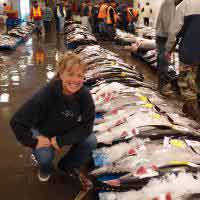When you click on a sponsoring school or program advertised on our site, or fill out a form to request information from a sponsoring school, we may earn a commission. View our advertising disclosure for more details.
Humans have created ingenious products throughout history. Necessity may be the mother of invention, but blueprints for some of our most impressive creations have found inspiration in the natural world. Biomimicry is a school of thought which observes and “borrows” features from the natural world in novel ways. The behaviors and defense mechanisms of plants, animals, and ecosystems have generated influential ways of thinking, living, and innovating.
Life on Earth depends on natural resources. But our ever-growing population and often destructive use resources won’t serve us into the distant future. That is why many people, including Janine Beynus are seeking better solutions. In her groundbreaking 1997 book, Biomimicry: Innovation Inspired by Nature, Beynus defined biomimicry as “imitating nature to create a more sustainable world.” She described that, “When we look at what is truly sustainable, the only real model that has worked over long periods of time is the natural world.” In an interview with the Center For Biologically Inspired Design, she added that nature’s “failures are fossils, and what surrounds us is the secret to survival.”
Biomimicry is thought by some as synonymous with sustainability and “being green.” Although those designations can be a part of biomimicry, the science of biomimicry is broader, studying exactly how something functions in nature, then applying that knowledge to improve human life.
For example, scientists studied how firefly scales amplify light, and used this research to find ways to amplify the brilliance of LED lights. Other scientists investigated how shark skin prevented creatures from attaching to them, which led to its use in hospitals as a method to prevent bacterial infection. Bloomberg News (2018) shared a collection of 14 spectacular “old-is-new” smart approaches inspired by nature that are being tried around the world by the acolytes of biomimicry.
Biomimicry can play a role in nearly every business and service, especially those focused on sustainability. The varied principles derived from observations can be embraced by accountants, anthropologists, architects, chemists, civil engineers, consultants, educators, farmers, inventors, lawyers, manufacturers, medical specialists, microbiologists, pharmaceutical developers, product and packaging designers, scientists, recycling coordinators, and others.
The related field of biomimetics derives design innovation from nature in pursuit of better technological solutions, but may have as its primary goal commercial success rather than sustainability. Regardless, the two fields are seen as highly related, and may be more similar than different, particularly in cases where the biomimetic application prioritizes sustainable design.
People with knowledge and interest in biomimicry topics can work at local, state, and federal regulatory agencies, as well as research firms, environmental or scientific firms, and other organizations seeking innovative ideas to do more with less and anticipate reduced natural resources.
Discover what to expect from an online master’s degree program in biomimicry, including information about coursework and a listing of outstanding professors with knowledge of related disciplines.
Featured Online Biomimicry Master’s Degree Program
Arizona State University (ASU) is the first and only institution offering a master of science (MS) in biomimicry. Coursework is available online via the ASU Biomimicry Center. The program is presented in collaboration with Biomimicry 3.8 and complements that organization’s certified biomimicry professional program. The degree requires completion of 17 classes for 30 credit-hours. the curriculum includes instruction in the essentials of biomimicry, life’s principles, biomimicry thinking, biomimicry and design, biomimicry and engineering, biomimicry and business, and teaching biomimicry. Students must complete two of four practicums and a culminating experience. The degree program builds on ASU’s online biomimicry graduate certificate program, a 15-credit program that includes five classes, a practicum, and a culminating experience.
- Location: Tempe, AZ
- Accreditation: The Higher Learning Commission
- Expected Time to Completion: Approximately one year
- Estimated Tuition: $834 per credit
Other Master’s Degrees Related to Biomimicry and Sustainability
Even though this is the only official biomimicry degree program, other schools include similar topics or classes, especially as part of environmental science programs. The following list summarizes several institutions offering master’s programs in environmental science or related fields that could provide opportunities to study or research biomimicry topics.
The Johns Hopkins University Krieger School of Arts and Science advanced academic programs include a master of science (MS) in energy policy and climate and an MS in environmental science and policy. Both are designed for interdisciplinary students interested in climate change and how energy systems impact human institutions and ecosystems, and both require ten classes to complete. Coursework is available online and on-campus, or as a hybrid of both formats. On-campus classes are held evenings and weekends as a convenience to working students. The environmental science and policy program requires one on-campus class, but the energy policy and climate program can be completed fully online.
- Location: Baltimore, MD
- Accreditation: Middle States Commission on Higher Education
- Expected Time to Completion: Approximately one year
- Estimated Tuition: $3,858 per course for energy policy and climate; $3,972 per course for environmental sciences and policy
The University of Denver offers a master of science in environmental policy and management with several concentration options, one of which is energy and sustainability. Students complete 12 courses and a capstone project for a total of 48 credit-hours. Coursework is available online, on-campus, or a blend of both.
- Location: Denver, CO
- Accreditation: The Higher Learning Commission
- Expected Time to Completion: Approximately one year
- Estimated Tuition: $660 per credit
Penn State University World Campus offers a master of professional studies in renewable energy and sustainability systems (sustainability management and policy option). Students complete 32 credit-hours and a capstone project to earn their degree. Coursework is fully available online. Students are not required to attend a residency or visit the campus.
- Location: University Park, PA
- Accreditation: Middle States Commission on Higher Education
- Expected Time to Completion: Self-paced, approximately one year
- Estimated Tuition: $853 per credit
Students can pursue three master of environmental science concentrations through the University of Idaho College of Natural Resources: physical, biological, and social science. Toward the end of the 30-credit program, they may choose between completing a thesis or performing additional research. All coursework is available online or on-campus.
- Location: Moscow, ID
- Accreditation: Northwest Commission on Colleges and Universities
- Expected Time to Completion: Self-paced, approximately one year
- Estimated Tuition: $474/credit-hour, plus $35/credit-hour for online classes
Finally, here are two other degrees related to biomimicry and sustainability which are offered on-campus:
Humboldt State University – On-Campus
Humboldt State University, a California State University campus, offers a master of science (MS) in natural resources. Coursework is interdisciplinary, and students prepare an individualized course of study. The program has four on-campus options, one of which is environmental and natural resource sciences. Students must complete 30 credit-hours and a culminating experience to earn their degree. Although this program isn’t presently online, Humboldt students that meet certain requirements may take online coursework at other CSU institutions for credit toward their Humboldt degree.
- Location: Arcata, CA
- Accreditation: Western Association of Schools and Colleges
- Expected Time to Completion: Two years
- Estimated Tuition: $476 per credit
Professors to Know in Schools with Programs Related to Biomimicry

Dr. Jerry L. Burgess is program director and senior lecturer at Johns Hopkins University’s environmental sciences and policy and geographic information systems programs. Dr. Burgess’ doctorate is in ecology and he is an experienced educator and consultant. His current research includes studying threats to ecosystems and environmental issues, including soil and groundwater remediation. His original training was as a metamorphic and structural petrologist, and he learned to utilize geochemical and petrologic tools to learn new things about igneous and metamorphic rocks and their role in the evolution of the Canadian Appalachians.

Dr. Laurie Richmond is an assistant professor of environmental planning at Humboldt State University. She has a bachelor of science in biology and her doctorate is in fisheries, wildlife, and conservation biology. As an interdisciplinary teacher, she brings natural, ecological, and social science elements together for her students. Her research interests are ocean and coastal planning and management, sustainable fisheries, and environmental conflicts. Dr. Richmond also heads a coastal research lab that focuses on natural resources, with an emphasis on marine and coastal issues plus the rights and perspectives of indigenous people.
